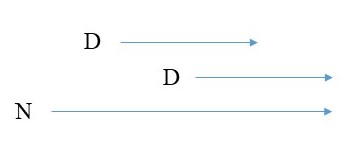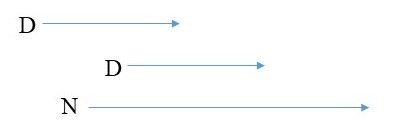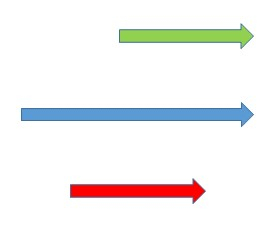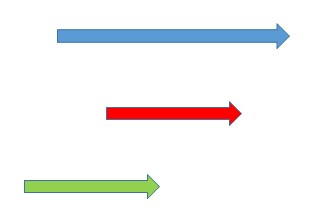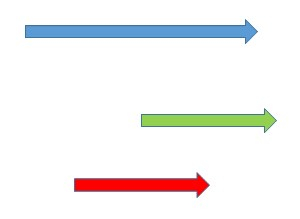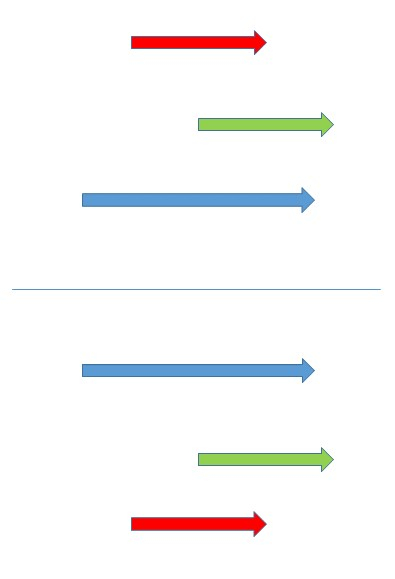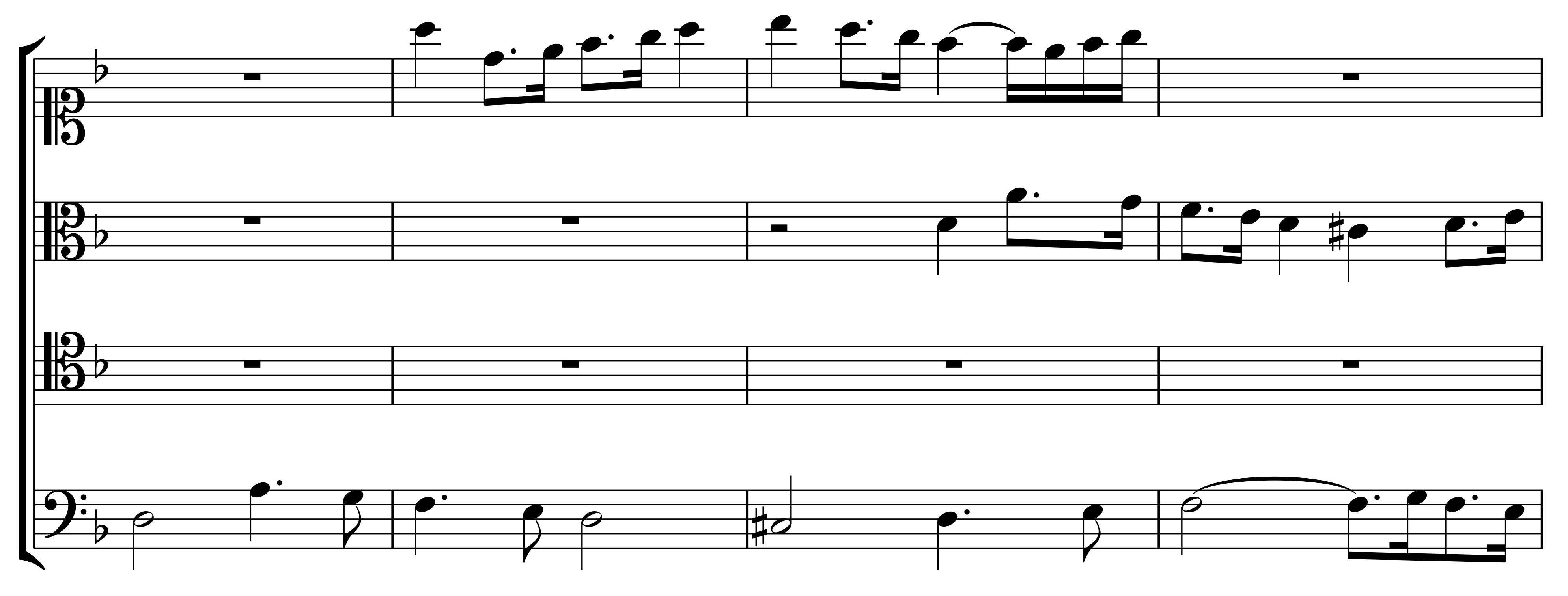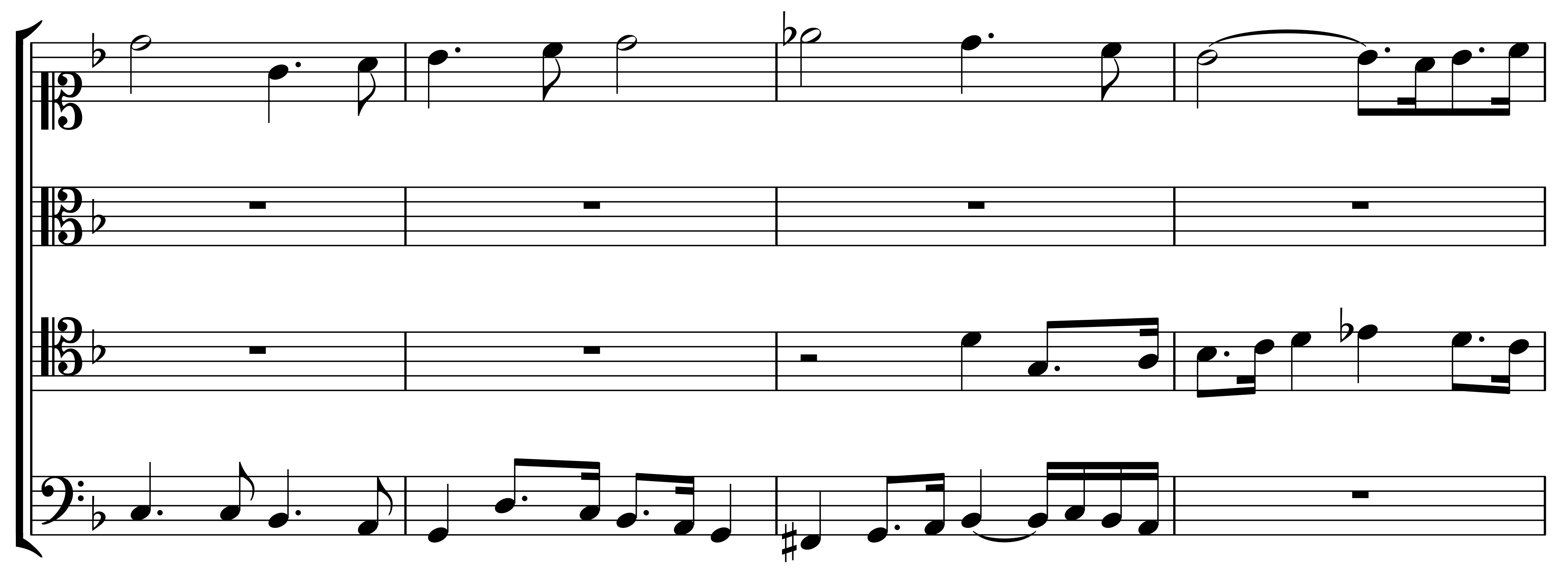The First Mirror inside the Contrapunctus 6 of the Art of Fugue by Johann Sebastian Bach (BWV 1080, 6)1All numbering in this essay regarding the works of Bach corresponds to the Schmieder catalogue (BWV).
Konstantinos G. Alevizos
| PDF | CITATION | AUTEUR |
Abstract
Johann Sebastian Bach had already elaborated the tool of double inversion, inside the Contrapunctus “in stylo francese” of the Art of Fugue. However, the counterpoint tool of double inversion is typical for the two later pairs of fugues BWV 1080, 12-13 a, b. After an examination of the global asset of the Contrapunctus 6, a particular attention is shown to the technique of inversion (mirror) in relation to fugues 12 and 13. Consequently a brief, but methodical, analysis succeeds to demonstrate the existence of totally symmetrical thematic phases inside Contrapunctus 6. The existence of double inversion inside an earlier Contrapunctus can indicate the level of premeditated elaboration in the whole work. Additionally, it could also suppose a parallel or contiguous time of the compositional process among the BWV 1080, 6, 12 and 13, which could re-impose a new examination of the correct order of the Contrapuncti.
Keywords: analysis; Johann Sebastian Bach; fugue; inversion; mirror.
Résumé
Cet article veut démontrer que Jean-Sébastien Bach avait déjà élaboré l’outil d’inversion complète (miroir) à l’intérieur du Contrapunctus in stylo francese de L’art de la fugue (BWV 1080, 6). L’outil de contrepoint de l’inversion complète est typique pour les deux paires ultérieures de fugues BWV 1080, 12-13 a, b. L’existence de l’inversion complète à l’intérieur d’un Contrapunctus antérieur (en relation avec les deux paires postérieurs) peut indiquer le niveau de préméditation dans l’élaboration du matériau de l’intégralité du recueil, en particulier dans la mesure où la notion de progression de complexité technique est concernée. En plus, il pourrait aussi supposer un temps parallèle ou contigu du processus de composition entre les BWV 1080, 6, 12 et 13, qui imposerait un nouvel examen de l’ordonnancement des fugues dans le recueil.
Mots clés : analyse ; Jean-Sébastien Bach ; fugue ; inversion ; miroir.
The Art of Fugue is a series of fugues or a fugue in series (Spitta [1899]2008, p. 198) based on increasing complexity. Consequently, this “cumulative work” (Dreyfus 1996, p. 1; Heinrich 1983, p. 3; Bagnall 1975, p. 59-61) establishes a continuous and increasing usage of many heterogeneous contrapuntal techniques that are taken for granted as the composer passes from one fugue to another inside the compositional process. On the other hand, this procedure somewhat confines the composer, who must not reveal from the beginning the “summa” of his technical artefacts and compositional skills but instead should let them emerge in an ensuing development until reaching the highest point of the work, where all the techniques so far are permitted.
This comprehensive structure permits the partitioning of the entire work in groups of fugues (sections), as shown in Figure 1, based on their technical characteristics and the presence of a specific subject in each one of them, as well as the use of other related material. The key to understanding the ordering issue of the fugues (which stands today as one of the most seducing problems about this work) lies within the acknowledgment of this increasing process. That is mainly because the links among the fugues that create the ordering process are based on the technical characteristics of each fugue. In this way, by understanding these links we can also understand the whole procedure that disciplines the ordering. In addition, defining the organization of the fugues inside the collection would also mean outlining the sections of the fugues that constitute this organization. Many efforts have been made to establish a definite order of the fugues inside these sections, as a result, scholars acknowledge different positions on this issue, but the most shared opinion examines the ordering of the fugues inside the identified sections rather than the ordering of the sections themselves. The sections of the Art of Fugue can be stated as shown in Figure 1.
The aim of this article is to provide clear evidence of the existence of premeditated mirrored constructions inside Contrapunctus 6 and to investigate the relation of the mirror technique present in Contrapunctus 6 with the rest of work. These inversed and reversed subject expositions (mirror) take place sporadically inside this “earlier” Contrapunctus as far as the ordering issue is concerned. That is because the “mirror” technique is typical for the two later pairs of fugues 12 and 13. In this way, we can acknowledge the fact that Bach interrupted in a way the use of increasing complexity inside the work by introducing a later technical element (the mirror) inside an earlier fugue as we will see in the next pages.
The table below (Figure 1) presents the division of the fugues in sections according to their major technical characteristics. This table is not exhaustive mostly because it does not display thoroughly the relations among the fugues, based on the use of the same material or same subjects.2Though the overall ordering of the fugues as presented inside Figure 1 could pose questions to some, I would like to consider it only as far as the fugues inside each section are concerned without giving importance to the ordering issue in the present essay. It is my opinion that in regarding the quality of each section, there can be no doubt about it; nevertheless, the terminology in use (simple, counter-, double, triple, quadruple and mirror fugues) can be discussed further. Nonetheless, it gives a clear description of the construction inside each section. Mainly, the presence of the subject in rectus or inversus in each fugue is the basic element that underlines the increasing complexity of the ensuing fugues. In addition, Bach presents two other major characteristics: the counter-fugues (and the stretto fugues3Bach introduces a typology of fugues that uses bidirectional subjects (rectus/inversus thus counter-fugues) inside the second section of the collection (5, 6 and 7). In addition, the exposition of these bidirectional subjects takes place simultaneously, creating stretto-fugues (6, 7).) and the mirror fugues. Undoubtedly, the mirror fugues are placed in a separate section because their main technique is that of inversion and reversion (Higgs 1876-1877, p. 48), which Bach did not apparently use in any other section.4This “reversion” technique or “an inversion as applied to the entire counterpoint” according to James Higgs, can be found only in the pair of fugues 12 and 13 and hidden occasionally inside Contrapunctus 6. As it would be inappropriate to begin the whole collection with a complex fugue technically speaking (in order to maintain the arrangement of increasing complexity), at the same time it would be rather inapt to make use of the mirror technique (inversion and reversion) at an “early” fugue without reusing it progressively in the ensuing fugues. In other words, when Bach presents a specific technique in a fugue for the first time, he uses this technique as a “background” for the upcoming ones, without being obliged to use it always (although he does so commonly). On the other hand, a synoptic figure that presents the relationship of one fugue to another can be stated as shown in Figure 2.
 Figure 1: Synoptic table of the sections inside the Art of Fugue with the material from the first edition.
Figure 1: Synoptic table of the sections inside the Art of Fugue with the material from the first edition.
 Figure 2: Ordering proposal and relations of one fugue to another.
Figure 2: Ordering proposal and relations of one fugue to another.
In Figure 2, the upper series is created based on Ms. P200 ordering and the appendix material (fugue 19), while the lower series proposal is based on the first edition’s material. The continuous lines indicate the coexistence of a fugue inside the same section, which is based on the use of similar technical criteria. The dotted lines indicate the use of common material for fugues that belong in different sections. The arrows indicate the final placements of the fugues (simple fugues, dotted fugues, double fugues, counter-fugues, triple fugues, mirror fugues, quadruple fugues).
A fact that only Jacques Chailley seemed to distinguish is that Bach had already used an “Ouverture à la française” in the middle of large compositions or collections (Chailley 1971, p. 52). He does mention the small overture inside the Goldberg Variations for the harpsichord, but many more could be mentioned.5I could also add to the list the first part of the fourth organ trio-sonata (BWV 528), the overture in the middle of the organ partita “Sei gegrüsset, Jesu gütig” (BWV 768), the fughetta “Wir glauben all an einem Gott” (BWV 681) in the middle of the third part of the Clavierübung, Prelude XIII of the second book of the Well-tempered Clavier (BWV 882), and the fourth partita for harpsichord BWV 824. By these means, it is clear that the presence of a second opening by using the overture formal tool in the middle of a greater composition should not surprise us.6Unfortunately, this is not the case for Contrapunctus 6, because it cannot be placed in the middle of the Art of Fugue. It is possible, however, to elaborate an ordering design according to which the dotted fugues (with fugue 5 as a matrix) constitute the second part of the whole composition. On the other hand, many attempts have been made to consider Contrapunctus 57For a detailed examination of the compositional techniques inside Contrapunctus 5, I suggest Alevizos 2019. and not 6, as a “stop” (not quite as an overture) inside the ensuing process of the fugues (Vartolo 2008, pp. 52, 57; Hughes 2006, p. 41; Wolf 2001, p. 434; Heinrich 1983, pp. 9–13; Chailley 1971, pp. 40–41; Dickinson 1950, p. 63).
Contrapunctus 6
Contrapunctus 6 is a fugue that uses all the compositional procedures of all the previous fugues, according to the concept of increasing technical progression8Moreover, by considering the technique of progression inside the work, we must accept the position of fugue 6 between fugues 5 and 7. That is mainly caused by the contrapuntal techniques presented in each fugue. Therefore, Contrapunctus 5 is a counter-fugue and stretto-fugue, Contrapunctus 6 a counter-fugue and stretto-fugue that uses diminution and Contrapunctus 7 a counter-fugue and stretto-fugue that uses both diminution and augmentation. This fact allows me to affirm that the second section seems to contain only three fugues (Chailley 1971, p. 52; Verchaly 1967, pp. 192–194). but also new ones such as an exaggeration and an unusual exploitation of the French Overture form (Dreyfus 1996, p. 163). Technically speaking, this fugue uses the exploitation of the codetta, the technique of diminution, the stretto and the inversion. Fugue 6 is the first of the second section, in which Bach begins to use techniques that are more elaborate (ibid., pp. 20–24; Dickinson 1956, pp. 126–127).9Bach also introduces the cadence, the harmonic pedal and the final re-exposition of the subject (in stretto) as a tool. The harmonic tactus changes in relation to the previous fugues and passes to the sixteenth note, so that the length of the fugue must be multiplied by two (79 x 2 = 158 bars).10The harmonic passage of the tactus between the manuscript and the edition for a small number of fugues is quite obvious inside the scores. These fugues are presented with sixteenth notes in the manuscript and in eighth notes in the edition. Although in the case of Contrapunctus 6, the diminution of the subject (in sixteenth notes) obliges Bach to maintain the sixteenth note value as a harmonic tactus for the whole fugue, this operation is the same in the two sources. In addition, the existence of a diminished subject allows the stretti to use three simultaneous subjects and a free counterpoint. Therefore, there can be three-voice combinations (stretto of the subject) in which two voices appear diminished (d) and one appears in the normal state (N). As it could probably seem obvious, the voice in a normal state always occupies the first or second position in the order of exposition of the voices inside a thematic phase (1N, 2d, 3d, or 1d, 2N, 3d but never 1d, 2d, and 3N). The typology and exploitation of these groups (stretti) of subjects can differ, as it can be shown in Figure 3.
a) Possible stretto dispositions.
b) Impossible stretto disposition.
Figure 3: Possible and impossible stretto dispositions.
The structure of Contrapunctus 6 does not seem at all similar to that of the previous fugue. Primarily, it is a counter-fugue and stretto fugue that uses the technique of diminution. The main elements are the sixteenth notes of the codetta, the dotted rhythm and an elaboration of the codetta in thirty-second notes, described as a “French roll” (Vartolo 2008, p. 54). The first inversion appears at the first bars of the fugue inside the stretto of the first thematic phase. It is created by the two external voices, although one is diminished and the other in a normal state. Hence, it is possible to identify in the first thematic phase the preamble of the “mirror” effect created by the notes (C# and B%); in fact, it is the axis of the median, using the terminology of Alan Dickinson, which is considered as a pivot in order to create the reversion effect (Gardonyi 1996, p. 22; Dickinson 1956, p. 129).
Furthermore, Bach does not use major episodes except from the first one, nor does he use large groups of thematic phases as he did in fugue 5. As has been said so far, fugue 6 contains all the elements of the preceding fugues, to which are added new ones. Upon closer inspection, it is possible to distinguish ten groups of thematic phases plus two single subject expositions. In addition, all the expositions of the subject use a mixed direction (rectus/inversus), unlike the previous fugue.
To my knowledge, there is no objection to the fact that Bach himself could have wished to include the indication “in stylo francese.” On the other hand, this indication is not present in the manuscript.11See Bach 1742-1746. Additionally, it is clear that according to the analysis of the score, the writing style of the fugue would envisage a French overture. In that case, the fact of applying or not a certain way of executing such a composition (surlié12I may perhaps be permitted to mention the notion of the “surlié,” a typical French concept, which consists of not executing the dotted notes as written when it comes to multiple-valued dotted notes. The execution of these dotted notes takes into consideration the smallest-valued dotted note by interpreting the biggest values according to the smallest. As a result, a dotted quarter note will be executed as a dotted eighth note in order to match harmonically with each other.) can generate harmonic inconsistencies with notes that do not coincide with the harmonic tactus from a vertical point of view. The same concern arises whenever the subject is presented in stretto, in normal and diminished values, as shown in Figure 4.
Bach introduced a new typology of exposition of the subject regarding the preceding fugues and in particular regarding the previous one. It is possible to note the presence of eight expositions with three subject entries, two expositions with two and two that seem to be isolated (Figure 5). On the other hand, it is not easy to distinguish the thematic phases unmistakably because it is not always clear which criteria to apply in order to regroup the apparently isolated thematic phases. In addition to this, Bach uses the voice of the tenor several times to introduce the subject, where normally it would have been expected in another voice. Nonetheless, it is possible to point out three groups of subject-expositions for which the first entry begins with the voice to which silence was attributed before the exposition itself. Indeed, this fact has been crucial for Chailley—he based his entire theory regarding the ordering issue of fugues on this fact (Chailley 1971). The overall structure of the fugue considers a gathering of stretti, more condensed at the beginning and at the end and rare in the central parts of the composition (bars 20–46). Furthermore, Bach introduces “bridges” (or brief episodes) of two voices inside this fugue.
I would like to confirm that all stretto expositions follow an almost regular order of entry regarding the voices. On the other hand, it is not possible to identify a symmetry similar to that of the previous fugue in which Bach had specifically elaborated the distance of entry of each voice.13Bach introduces in the previous fugue (Contrapunctus 5) an element that will become the most characteristic of the whole fugue, in order to make clearer the distinction among the entries of the subject. Apart from the voice’s choice (SATB), there is a methodical introduction of the subjects by their direction (rectus/inversus), and especially the distance of entry of the voices in each thematic phase (always in stretto). By these means, Bach creates groups of thematic phases in which the entries of the subjects have the same distance (for all of the voices concerned inside a specific group). Technically, the second thematic phase (bars 33–45) uses mixed direction (rectus/inversus) … Continue reading Moreover, by examining the voice entries of the subject in the stretti, it is clear that the first entry of any combination is the same (Dickinson 1956, p. 126; Higgs 1876-1877, pp. 51–53). The second entry always occurs after a whole note. In addition, in three-voice stretti, the third entry can be irregular, with note-value differences ranging from one (bars 15–19) to five half-notes (bars 6–12).
 Figure 4: First thematic phase of Contrapunctus 6, harmonic inconsistencies resolved with the surlié effect.
Figure 4: First thematic phase of Contrapunctus 6, harmonic inconsistencies resolved with the surlié effect.
 Figure 5: Morphological structure of Contrapunctus 6 presenting the thematic phases (d = diminished, R = rectus, I = inversus, * = elaborated).
Figure 5: Morphological structure of Contrapunctus 6 presenting the thematic phases (d = diminished, R = rectus, I = inversus, * = elaborated).
With the transformation of the harmonic tactus, Bach has succeeded in creating long phrases that generate the diminished stretti, a phenomenon that will be elaborated more exhaustively in the following fugue (in which the three value-states, normal, diminished and augmented are put together). Normally, in the case of triple subject-expositions (Figure 6), the two diminished voices have a different direction than the one in a normal value state (rectus/inversus). I am convinced that Bach did not intend to comprehensively elaborate the stretto device in this fugue, in order to be able to do so at the following one; thus, the three-voice canonical expositions have an order of type: dNd or Ndd, but never ddN.14N=Normal, d=diminished. It is true that Bach will elaborate exhaustively several stretto possibilities of the subject in augmented, diminished and normal state form in the following fugue (7). Similarly, in the case of a two-voice stretto, the first voice is always in normal values, a phenomenon that is quite logical in order to maintain the juxtaposition of the two elements.
 Figure 6: Example of the first thematic phase.
Figure 6: Example of the first thematic phase.
There is an affinity between the episodes of bars 29–30 and 44–45. These two episodes divide the entire fugue in three parts: bars 1–30, 31–45 and 46–79. As it has been already mentioned, it is possible to affirm that the first and the last parts are denser and ampler in relation to the central one (due especially to a relative absence of three-subject stretto). The subject expositions in major tones appear to play the role of elaboration inside the composition (Levarie and Merrick 1943, p. 16), instead of acquiring the role of a thematic phase, and give the impression of creating a sort of “interlude.” Figure 7 demonstrates that only in its third part does the fugue possess a symmetry of construction. Moreover, this division can be schematized as show below.
 Figure 7: Morphological structure of Contrapunctus 6 in three parts (P=Pont, E=Episode).15Numbers correspond to the number of voices that take place in each thematic phase.
Figure 7: Morphological structure of Contrapunctus 6 in three parts (P=Pont, E=Episode).15Numbers correspond to the number of voices that take place in each thematic phase.
This brief analysis of the score presented so far focused essentially on the thematic phases, illustrates the central technique that Bach used in this fugue. Nevertheless, as in every other fugue in the collection, it is not possible to qualify a fugue by an isolated technique, mainly because the process of increasing complexity is being assumed in each case by several simultaneous procedures. Thus, this fugue elaborates for the first time the diminution (of the subject as well as of other elements), which is presented in a two and three voice-stretto and in both directions (rectus/inversus). I would like to remind the reader that this section of the Art of Fugue (fugues 5, 6 and 7) generally employs the stretto technique in a bidirectional form, the dotted subject, and the techniques of diminution and augmentation. Undeniably, Bach begins the section with the dotted rhythm and the bidirectional exposition (counter-fugue) in Contrapunctus 5, in order to advance with the same characteristics in stretto with diminution in Contrapunctus 6. The last fugue of the section, Contrapunctus 7, uses all these techniques, in addition to the technique of augmentation, and always in a more complex and sophisticated manner.
The “Mirror” Effect
The two mirror fugues that use the technique of complete inversion (and reversion according to James Higgs), 12 and 13, have been a singular point of interest for musicians and musicologists since their publication, and they were most likely for Bach himself, as Albert Schweitzer stated (Schweitzer [1905]1966, p. 428). Dickinson speaks of inversion as a nonmusical method of expressing Bach’s determination of elaborating this specific technical tool (Dickinson 1956, p. 140), Friedrich W. Marpurg uses these two couples of fugues in his Abhandlung von der Fuge to explain the meaning of the “fuga inversa” (Mann [1956]1987, p. 187) and Lorenz C. Mizler mentions the reversion technique used in the Art of Fugue in Bach’s obituary, which was published four years after the composer’s death (Mizler 1754, p. 168). Furthermore, I would certainly agree that an “extreme rigor of style and plan” (Chailley 1971, p. 61) characterizes these two fugues.
From a formal point of view, Bach had the opportunity to use the technique of subject inversion already in the first section, having inverted the subject in fugue 3 (and later in fugue 4). In addition, the entire second section (fugues 5-7) uses the subjects in both directions simultaneously, creating counter-fugues (Hughes 2006, p. 117–118; Chailley 1971, p. 35).
The harmonic context of the fugues that use the inversion and reversion techniques (12 and 13) deserves special attention. Moreover, the apparent aesthetic homeomorphism of these compositions, which arises from the obligation of the inversion and which Laurence Dreyfus considers with rather austere criteria as an erroneous direction regarding the harmonic result of the reversed fugues, might have seemed rather stimulating to Bach’s contemporaries (Dreyfus 1996, p. 164).
The “mirror” effect (defined as “reversed movement” by Higgs) takes place when two conditions are satisfied. Firstly, it is applied on the axis of the median (the F note) by the inversion of the intervals (Figure 8).
Secondly, it applies to the reversion of the positioning of the voices (mirror effect). In this phase the inherent inversion of the intervals is automatic and comes naturally by flipping the voice (Figure 9).
Hence, this technique seems to concern fugues 12 and 13, as commonly suggested, although it is true that only fugue 12 uses both inversion and reversion (mirror) (Higgs 1876-1877, p. 65-66). As Chailley pointed out, in a very crafty way, the mirror effect can be literally achieved when placing the score vertically on a mirror. Consequently, the mirror effect does not apply to fugue 13, since it does not exist as we can see in Figure 10 because the three voices are not reversed (mirrored) in a symmetrical way. The reversion (present in the Art of Fugue only in Contrapunctus 12) uses the interval pivot on the median but also the positioning of each voice in symmetry. Thus, Figure 10 presents the mirror effect inside Contrapunctus 12, where the voices are inverted as an interval and reversed regarding their position, as well as the inversion in Contrapunctus 13 without the reversion of the voices.
Harmonically, the inversion of each note must be examined separately, because the “result” of one affects that of the other. With the creation of a symmetry around the median in these fugues, this axis becomes the basis for the complete inversion of each voice. The act of creating an exchange between the roles of the voices (reversion) is secondary (Chailley 1971, p. 35). Figure 11 presents three possible dispositions (b) of an invertible triple counterpoint set (a) as well as the possibility of a reversible triple counterpoint (c) as found inside fugue 6.
Figure 10: Creation of the “mirror effect” with the symmetrical positioning, Contrapuncti 12 and 13.
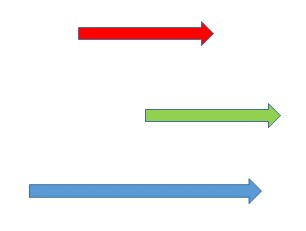 a) Original pattern of triple counterpoint.
a) Original pattern of triple counterpoint.
b) Three possible variations of invertible triple counterpoint.
c) “Mirror” effect (reversible triple counterpoint) applied on the triple invertible counterpoint.
Figure 11: The technique of Reversion and the reversible counterpoint.
The inversion of the intervals, as Bach uses it, always corresponds to the quantity of the interval (second, third, etc.), while the quality (major, minor, etc.) is left to the choice of the context without implying any obligation to the composer. Therefore, when possible, Bach can decide which alterations to choose (quality) in the inversion having the possibility to modulate or not. Undeniably, the composition of a work in inversion and reversion is quite similar to that of the canon, in the sense that it always considers a current and continuous adaptation according to the desired future result. Therefore, it is possible to reach quite different results, if in a first step we reproduce the inverted intervals (quantity) and in a second their quality.
The reversion of the subject presents no harmonic complications in regard to the main tone because its implicit inversion on the axis of the median does not modify its harmonic background. On the other hand, the result of a “double effect” of inversion and reversion can lead to an artificially ambiguous harmonic context in which the subjects in rectus and inversus are not clearly differentiated as we see in Figure 12. Inside this pair of fugues (specifically in fugue 13) Bach uses a “mirror inside a mirror,” by introducing in the rectus version (13a) the subjects in both rectus and inversus arrangements. This effect can be explained by monitoring the direction of the subjects (rectus/inversus).
 Figure 12: The “double mirror” effect on the subjects as created inside Contrapunctus 13; incipit of Contrapuncti 13a and 13b.
Figure 12: The “double mirror” effect on the subjects as created inside Contrapunctus 13; incipit of Contrapuncti 13a and 13b.
By using the subject in both rectus and inversus forms inside the “rectus” version of fugue 13, Bach succeeds in creating the opposite forms in the “inversus” version. Thus, the distinction of the subject in rectus or inversus is automatically dissolved. In this way, the rectus form of the subject in the “rectus” version will become inversus in the “inversus” version, but the inversus form of the subject in the “rectus” version will become rectus in the “inversus” version (and vice versa). In contrast, inside fugue 12 (which is the proper mirror fugue of the collection), all the subjects in the “rectus” version are presented in rectus form, consequently creating the inversus form of the subject in the “inversus” version of the fugue. This is a quite interesting consideration that could give a whole new meaning to the concept of “section” inside the Art of Fugue. That is because it creates a secondary criterion of division inside the specific section of the so-called mirror fugues. Therefore, while on one hand Contrapunctus 12 examines the mirror effect properly speaking, where all voices are inverted and reverted, on the other hand, Contrapunctus 13 (by not examining the mirror effect globally as shown in Figure 10) uses the subject simultaneously in rectus and inversus forms in the “rectus” fugue by creating the exact opposite in the “Inversus” one. In this way, the double mirror effect inside Contrapunctus 13 takes place.
A similar procedure can be acknowledged regarding the distinction between dux and comes (subject/answer). The construction of the subject in the Art of Fugue used in these mirrors allows the suggestion of several possibilities at a single exposition regarding this fact. These possibilities have to do mainly with the presence of the subject in a rectus or inversus form that is being used as dux or comes inside the compositional plot of the fugue. Additionally, the modulations as identified in the rectus version must be considered in immediate relation with the inverted version (Azzaroni 2000, pp. 99–100).
Contrapunctus 6 and the “Mirror” Effect
Figure 13 gives an example of two thematic phases that use a three-subject stretto, based on one voice in normal value state (rectus) and two in a diminished state (inversus/rectus), creating the sequence Ndd. On the other hand, bars 35–38 are similar, with the addition of a free-counterpoint voice for the alto, creating the sequence Ndd (inversus/rectus/inversus).
Figure 13: Contrapunctus 6, bars 1–4 and 35–38 of the voices (reversion); fugues 12a, b and 13a, b.
By examining these two expositions attentively, it is possible to recognize that this is a completely symmetrical pair of thematic phases. It is necessary to remove the parts not concerned (the alto voice in the second group) in order to visualize the mirror effect (Figure 14).
Figure 14: Mirrored thematic phases; Contrapunctus 6, bars 1–4 and 35–38.
Hence, it is clear that Bach not only maintained the function of inversion of each voice but also used it in a symmetrical way (reversion) according to the mirror. Consequently, we observe harmonically in the second case the perfect reversion (mirror) of what we find in the first. The complementary voice (alto) “completes” the already imposed harmonic context; therefore, it can be easily removed from the second group. This practice is close (even if it is a contrario) to what Dreyfus pointed out about the use of a complementary voice in triple-counterpoint fugues (Dreyfus 1996, pp. 163–164). However, in the case of Contrapunctus 6, this identical three-voice stretto is presented twice, giving undeniable proof of the existence of reversible triple-counterpoint inside the fugue. On the other hand, what changes between these two thematic phases is the presentation tone (D and G), but the function remains unaltered.
The first five fugues primarily use a harmony included inside the interval of a fifth (two thirds, one above and one below from the median axis), or harmonic contexts derived from progressions of relative triads (thus using two common notes).16D-F-A, F-A-C or B-D-F. Starting with fugue 6, this context expands without reaching the harmonic typology of mirror-modulations present in the pair of inverted fugues (12 and 13).
Consequently, the fact that Contrapunctus 6 uses the mirror technique (inversion/reversion) that will be used only in the penultimate section of the collection (fugues 12 and 13), interrupts in a way Bach’s premeditated plan as far as the whole work in concerned. Regrettably, I am not able to state a clear opinion as to the reason that led Bach to bypass his own rules regarding the progression process.17The fact of interrupting the supposed pre-organized arrangement of techniques inside the work as a whole could also be the result of a second thought made by the composer based on completely extra-musical criteria. I would like to suggest, for instance, the uncertain fact that led to the final arrangement of the Two-part Inventions (1723) deriving from the previous Preambula (1720–1723). Thus, from a clear pedagogical structure based on keyboard complexity (Preambula), Bach decided to deliver an edition based on a pitch elevation by tone. It is clear on the other hand that the mirror effect should not have been used inside Contrapunctus 6 in order to be able to confirm the progressive development inside the whole work. However, the fact remains, to my knowledge, Bach did not develop the mirror technique outside these three fugues (i.e., 6, 12 and 13). In addition, it would be possible to affirm that Bach was keen on introducing an element or a technique in an earlier fugue inside the work’s progression, before taking it under consideration for a thorough exploitation in a later one. That could suggest the liberty taken on behalf of the composer not to follow a rigid initial scheme. It is the case, for example, in Contrapunctus 10, which uses four different elements as subjects in four separate thematic phases in relation to fugue 11, which introduces four distinct thematic elements. I could also mention the composition of the entire Contrapunctus 4,18For further details on this fugue I suggest two links that describe the overall structure of Contrapunctus 4, see Alevizos 2015a and Alevizos 2015b. which apparently is part of the section of the “simple” fugues, although due to its extreme formal complexity it has almost nothing to share with the other fugues of its section. Again, and by entering into more precise technical issues, I could refer to a series of harmonic elements that are recurring in different fugues and can be acknowledged as a summa in Contrapunctus 19. From this point of view, it could be accepted (if not expected) that Bach decided to include the mirror technique in an earlier fugue before developing it thoroughly (in two different ways as has been seen) in two later ones. It is my belief that the key of understanding the complexity of the work is still to be found and that is because the Art of Fugue relates to any aspect of analysis that can be applied to it.
Bibliography
Alain, Olivier (1975), “Un supplément inédit aux Variations Goldberg de J.S. Bach,” Revue de Musicologie, t. 61, no 2, pp. 244–294.
Alevizos, Konstantinos (2015a), “Formes cachées d’organisation rythmique dans le Contrapuntus IV (BWV 1080, 4) de L’Art de la Fugue,” http://www.musicologie.org/15/formes_cachees_d_organisation_rythmique.html, accessed 17 July 2019.
Alevizos, Konstantinos (2015b), “L’Art de la fugue de Johann Sebastian Bach. La structure morphologique du Contrapunctus IV (BWV 1080, 4) : une fugue postérieure,” http://www.musicologie.org/15/l_art_de_la_fugue_de_johann_sebastian_bach.html, accessed 17 July 2019.
Alevizos, Konstantinos (2019), “Parameters of Stretto Use inside the Contrapunctus 5 of the Art of Fugue by Johann Sebastian Bach (BWV 1080, 5),” Revue musicale OICRM, vol. 6, no 1, https://revuemusicaleoicrm.org/rmo-vol6-n1/parameters-of-stretto/, accessed 15 July 2019.
Azzaroni Loris (2000), Ai confini della modalità. Le toccate per cembalo e organo di Girolamo Frescobaldi, Bologna, CLUEB.
Bach, Johann Sebastian (c1742-1746), Die Kunst der Fuge, BWV 1080, Mus. Ms. Bach P 200, Staatsbibliothek zu Berlin – Preussischer Kulturbesitz, https://digital.staatsbibliothek-berlin.de/werkansicht?PPN=PPN86332598X&PHYSID=PHYS_0053&DMDID=, accessed 12 August 2019.
Bagnall, Anne (1975), “The Simple Fugues,” in Christoph Wolff (ed.), “Seminar Report. Bach’s Art of Fugue: An Examination of the Sources,” Current Musicology, no 19, pp. 59–61, https://currentmusicology.columbia.edu/wp-content/uploads/sites/13/2016/09/current.musicology.19.full_.pdf, accessed 12 August 2019.
Baker, Thomas (1975), “Bach’s Revisions in the Augmentation Canon,” in Christoph Wolff (ed.), “Seminar Report. Bach’s Art of Fugue: An Examination of the Sources,” Current Musicology, no 19, pp. 67–71, https://currentmusicology.columbia.edu/wp-content/uploads/sites/13/2016/09/current.musicology.19.full_.pdf, accessed 12 August 2019.
Bitsch, Marcel, and Jean Bonfils (1981), La fugue, Paris, Presses Universitaires de France.
Butler, Gregory G. (1983), “Ordering Problems in J. S. Bach’s Art of Fugue Resolved,” The Musical Quarterly, vol. 69, no 1 (Winter), pp. 44–61, https://doi.org/10.1093/mq/LXIX.1.44, accessed 12 August 2019.
Butler, Gregory G., Stauffer, George B., and Mary Dalton Freer (ed.) (2008), About Bach, Urbana, University of Illinois Press.
Chailley, Jacques (1967), “L’ordre des morceaux dans L’Art de la Fugue,” Revue de Musicologie, t. 53, no 2, pp. 110–136.
Chailley, Jacques (1971), L’Art de la Fugue de J.-S. Bach, Paris, A. Leduc.
Corten, Walter (1987), “Un renversement peut en cacher un autre, ou un aspect inédit du Contrepoint 18 de L’Art de la fugue,” Revue de Musicologie, t. 73, no 2, pp. 203–226.
Corten, Walter (1988a), “La dernière Fugue. Pièce inachevée ou ouverture sur l’infini? Contribution à l’étude du Contrepoint BWV 1080, 19 de L’Art de la fugue de J.S. Bach », Analyse musicale, no 11, pp. 61–65.
Corten, Walter (1988b), “L’Art de la Fugue de J.S. Bach. Un plan à ‘dé-chiffrer’?,” Analyse musicale no 13, pp. 75–79.
Dentler, Hans-Eberhard (2000), L’Arte della fuga di Johann Sebastian Bach. Un’opera pitagorica e la sua realizzazione, Milano, Skira.
Dickinson, Alan E. F. (1950), The Art of J.S. Bach, 2nd rev. ed., London, Hinrischen Edition.
Dickinson, Alan E. F. (1956), Bach’s Fugal Works, with an Account of Fugue before and after Bach, London, I. Pitman.
Dreyfus, Laurence (1996), Bach and the Patterns of Invention, Cambridge, Harvard University Press.
Forkel, Johann-Nikolaus ([1802]2000), Vie de Johann-Sebastian Bach, Paris, Flammarion.
Franck, Peter (2010), “‘A Fallacious Concept.’ Invertible Counterpoint at the Twelfth within the Ursatz,” Music Theory Spectrum, vol. 32, no 2 (Fall), pp. 121–144, https://doi.org/10.1525/mts.2010.32.2.121, accessed 12 August 2019.
Gárdonyi, Zsolt (1966), La struttura della fuga di Johann Sebastian Bach, Milano, Ricordi.
Gedalge, André (c1989), Μελέτη της φούγκας [Traité de la fugue], trad. Κ. Νάσος, Athens, Νάσος.
Göncz, Zoltán (1996), “Reconstruction of the Final Contrapunctus of The Art of Fugue,” International Journal of Musicology, vol. 5, pp. 25–93.
Göncz, Zoltán (2013), Bach’s Testament. On the Philosophical and Theological Background of the Art of Fugue, Lanham, The Scarecrow Press.
Heinrich, Adel (1983), Bach’s Die Kunst Der Fuge. A Living Compendium of Fugal Procedures, with a Motivic Analysis of all Fugues, Lanham, University Press of America.
Higgs, James (1876-1877), “Bach’s ‘Art of Fugue’,” Proceedings of the Musical Association, 3rd Session, pp. 45–73.
Hofmann, Klaus (1996), Neue Ausgabe sämtlicher Werke [von] Johann Sebastian Bach, kritischer Bericht, Serie VII, Band 2, “Die Kunst der Fuge,” Kassel, Bärenreiter.
Houten, Kees van, and Marinus Kasbergen (2003), Bach et le nombre. Une recherche sur la symbolique des nombres et les fondements ésotériques de ceux-ci dans l’œuvre de Johann Sebastian Bach, Liège, Mardaga.
Hughes, Nicholas (2006), Accident or Design? New Theories on the Unfinished Contrapunctus 14 in J. S. Bach’s The Art of Fugue BWV 1080, Ph.D. diss., The University of Auckland, https://researchspace.auckland.ac.nz/bitstream/handle/2292/392/01front.pdf?sequence=10, accessed 12 August 2019.
Keller, Hermann (1991), Il Clavicembalo ben Temperato di J. S. Bach, Ricordi, Milan.
Kermann, Joseph (2005), The Art of Fugue. Bach Fugues for Keyboard, 1715-1750, Berkeley, University of California Press.
Lester, Joel (1989), Between Modes and Keys. German Theory, 1592-1802, Stuyvesant, Pendragon Press.
Levarie, Siegmund, and Arnold Merrick (1943), “Fugue and Form,” Bulletin of the American Musicological Society, vol. 7 (October), pp. 15–17, https://doi.org/10.2307/829331, accessed 12 August 2019.
Mann, Alfred ([1956]1987), The Study of Fugue, New York, Dover.
Mizler, Lorenz Christoph (1754), Musikalische Bibliothek, vol. 4, Leipzig, Im Mizlerischer Bücher-Verlag, https://archive.org/details/MusikalischeBibliothek4.band1754, accessed 12 August 2019.
Renwick, William (1991), “Structural Patterns in Fugue Subjects and Fugal Expositions,” Music Theory Spectrum, vol. 13, no 2 (Fall), pp. 197–218, https://doi.org/10.2307/745898, accessed 12 August 2019.
Rivera, Benito V. (1978), “Bach’s Use of Hitherto Unrecognized Types of Countersubjects in the Art of Fugue,” Journal of the American Musicological Society, vol. 31, no 2, pp. 344–362, https://doi.org/10.2307/831001, accessed 12 August 2019.
Schleuning, Peter (1993), Johann Sebastian Bachs “Kunst der Fuge.” Ideologien, Entstehung, Analyse, Kassel, Bärenreiter.
Schweitzer, Albert ([1911]1966), Johann Sebastian Bach, New York, Dover.
Sheldon, David A. (1990), “The Stretto Principle. Some Thoughts on Fugue as Form,” The Journal of Musicology, vol. 8, no 4 (Autumn), pp. 553–568, https://doi.org/10.2307/763535, accessed 12 August 2019.
Spitta, Philipp ([1899]2008), Johann Sebastian Bach. His Work and Influence on the Music of Germany, 1685-1750, translated by Clara Bell and J. A. Fuller-Maitland, vol. 3, Amarillo, Jones Press.
Stauffer, George (1985), “Bach as Reviser of his Own Keyboard Works », Early Music, vol. 13, no 2 (May), pp. 185–198, https://doi.org/10.1093/earlyj/13.2.185, accessed 12 August 2019.
Tatlow, Ruth (1991), Bach and the Riddle of the Number Alphabet, Cambridge, Cambridge University Press.
Tatlow, Ruth (2016), Bach’s Numbers. Compositional Proportion and Significance, Cambridge, Cambridge University Press.
Tovey, Donald F. ([1931]1974), A Companion to The Art of Fugue, London/New York, Oxford University Press.
Vartolo, Sergio (2008), Johann Sebastian Bach, Homo Universalis. Die Kunst Der Fugue, Firenze, SPES.
Verchaly, André (1967), Review of the book L’Art de la Fugue by J.-S. Bach (“Introduction, analyse et commentaires par Marcel Bitsch”), Revue de Musicologie, vol. 53, no 2, pp. 192–194.
Walker, Paul ([2000]2009), Theories of Fugue form the Age of Josquin to the Age of Bach, Rochester, Rochester University Press.
Wiemer, Wolfgang (1977), Die wiederhergestellte Ordnung in Johann Sebastian Bachs Kunst der Fuge. Untersuchungen am Originaldruck, Wiesbaden, Breitkopf & Hartel.
Wolff, Christoph (1975), “The Last Fugue. Unfinished?,” in Christoph Wolff (ed.), “Seminar Report. Bach’s Art of Fugue: An Examination of the Sources,” Current Musicology, no 19, pp. 71–77, https://currentmusicology.columbia.edu/wp-content/uploads/sites/13/2016/09/current.musicology.19.full_.pdf, accessed 12 August 2019.
Wolff, Christoph (1991), Bach. Essays on his Life and Music, Cambridge, Harvard University Press.
| RMO_vol.6.2_Alevizos |
Attention : le logiciel Aperçu (preview) ne permet pas la lecture des fichiers sonores intégrés dans les fichiers pdf.
Citation
- Référence papier (pdf)
Konstantinos G. Alevizos, « The First Mirror inside the Contrapunctus 6 of the Art of Fugue by Johann Sebastian Bach (BWV 1080, 6) », Revue musicale OICRM, vol. 6, no 2, 2020, p. 107-125.
- Référence électronique
Konstantinos G. Alevizos, « The First Mirror inside the Contrapunctus 6 of the Art of Fugue by Johann Sebastian Bach (BWV 1080, 6) », Revue musicale OICRM, vol. 6, no 2, 2020, mis en ligne le 30 janvier 2020, https://revuemusicaleoicrm.org/rmo-vol6-n2/the-first-mirror/, consulté le…
Auteur
Konstantinos G. Alevizos, Université Aix-Marseille
Konstantinos Alevizos holds a PhD in musicology (Paris-Sorbonne University) and a qualification MCF by the French national universities’ council. He is also a composer and an organist. He has followed an international course in Greece (Klassiko Odeio), Italy (Scuola di Paleografia and Filologia Musicale), France (Jean-Monnet University and Paris-Sorbonne) and Switzerland (HEM of Geneva), in music and musicology. He is also a member of the Scientific Committee of the Revue Musicorum journal. Former organ professor at the Conservatory of Chambéry Pays de Savoie, in France, he is currently temporary attached in the SATIS department of Aix-Marseille University in composition and analysis as well as member of the Center for the State Diploma in dance, Dance Mouvance, Isle-sur-la-Sorgue. He is co-founder of the association Artemida (www.artemida.fr).
Notes
| ↵1 | All numbering in this essay regarding the works of Bach corresponds to the Schmieder catalogue (BWV). |
|---|---|
| ↵2 | Though the overall ordering of the fugues as presented inside Figure 1 could pose questions to some, I would like to consider it only as far as the fugues inside each section are concerned without giving importance to the ordering issue in the present essay. It is my opinion that in regarding the quality of each section, there can be no doubt about it; nevertheless, the terminology in use (simple, counter-, double, triple, quadruple and mirror fugues) can be discussed further. |
| ↵3 | Bach introduces a typology of fugues that uses bidirectional subjects (rectus/inversus thus counter-fugues) inside the second section of the collection (5, 6 and 7). In addition, the exposition of these bidirectional subjects takes place simultaneously, creating stretto-fugues (6, 7). |
| ↵4 | This “reversion” technique or “an inversion as applied to the entire counterpoint” according to James Higgs, can be found only in the pair of fugues 12 and 13 and hidden occasionally inside Contrapunctus 6. |
| ↵5 | I could also add to the list the first part of the fourth organ trio-sonata (BWV 528), the overture in the middle of the organ partita “Sei gegrüsset, Jesu gütig” (BWV 768), the fughetta “Wir glauben all an einem Gott” (BWV 681) in the middle of the third part of the Clavierübung, Prelude XIII of the second book of the Well-tempered Clavier (BWV 882), and the fourth partita for harpsichord BWV 824. |
| ↵6 | Unfortunately, this is not the case for Contrapunctus 6, because it cannot be placed in the middle of the Art of Fugue. It is possible, however, to elaborate an ordering design according to which the dotted fugues (with fugue 5 as a matrix) constitute the second part of the whole composition. |
| ↵7 | For a detailed examination of the compositional techniques inside Contrapunctus 5, I suggest Alevizos 2019. |
| ↵8 | Moreover, by considering the technique of progression inside the work, we must accept the position of fugue 6 between fugues 5 and 7. That is mainly caused by the contrapuntal techniques presented in each fugue. Therefore, Contrapunctus 5 is a counter-fugue and stretto-fugue, Contrapunctus 6 a counter-fugue and stretto-fugue that uses diminution and Contrapunctus 7 a counter-fugue and stretto-fugue that uses both diminution and augmentation. This fact allows me to affirm that the second section seems to contain only three fugues (Chailley 1971, p. 52; Verchaly 1967, pp. 192–194). |
| ↵9 | Bach also introduces the cadence, the harmonic pedal and the final re-exposition of the subject (in stretto) as a tool. |
| ↵10 | The harmonic passage of the tactus between the manuscript and the edition for a small number of fugues is quite obvious inside the scores. These fugues are presented with sixteenth notes in the manuscript and in eighth notes in the edition. Although in the case of Contrapunctus 6, the diminution of the subject (in sixteenth notes) obliges Bach to maintain the sixteenth note value as a harmonic tactus for the whole fugue, this operation is the same in the two sources. |
| ↵11 | See Bach 1742-1746. |
| ↵12 | I may perhaps be permitted to mention the notion of the “surlié,” a typical French concept, which consists of not executing the dotted notes as written when it comes to multiple-valued dotted notes. The execution of these dotted notes takes into consideration the smallest-valued dotted note by interpreting the biggest values according to the smallest. As a result, a dotted quarter note will be executed as a dotted eighth note in order to match harmonically with each other. |
| ↵13 | Bach introduces in the previous fugue (Contrapunctus 5) an element that will become the most characteristic of the whole fugue, in order to make clearer the distinction among the entries of the subject. Apart from the voice’s choice (SATB), there is a methodical introduction of the subjects by their direction (rectus/inversus), and especially the distance of entry of the voices in each thematic phase (always in stretto). By these means, Bach creates groups of thematic phases in which the entries of the subjects have the same distance (for all of the voices concerned inside a specific group). Technically, the second thematic phase (bars 33–45) uses mixed direction (rectus/inversus) with the entry distance of a half-note. Furthermore, there is a group that uses the distance of two half notes either in rectus or in inversus, hence not mixed (bars 69–81). And finally, there is a group (either rectus or inversus, again not mixed), which presents the voices in pairs, using an entry distance of three half notes (bars 47–62). It is therefore clear that Bach created a plan according to which each thematic phase (stretto exposition of the subject) acquired a specific entry distance for all the subject-expositions concerned. |
| ↵14 | N=Normal, d=diminished. It is true that Bach will elaborate exhaustively several stretto possibilities of the subject in augmented, diminished and normal state form in the following fugue (7). |
| ↵15 | Numbers correspond to the number of voices that take place in each thematic phase. |
| ↵16 | D-F-A, F-A-C or B-D-F. |
| ↵17 | The fact of interrupting the supposed pre-organized arrangement of techniques inside the work as a whole could also be the result of a second thought made by the composer based on completely extra-musical criteria. I would like to suggest, for instance, the uncertain fact that led to the final arrangement of the Two-part Inventions (1723) deriving from the previous Preambula (1720–1723). Thus, from a clear pedagogical structure based on keyboard complexity (Preambula), Bach decided to deliver an edition based on a pitch elevation by tone. |
| ↵18 | For further details on this fugue I suggest two links that describe the overall structure of Contrapunctus 4, see Alevizos 2015a and Alevizos 2015b. |

